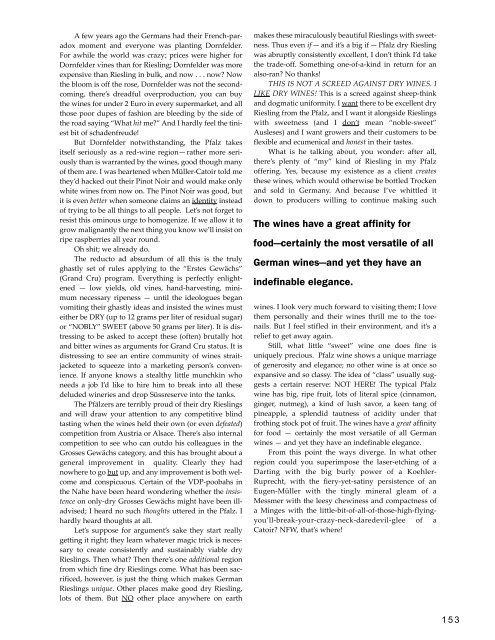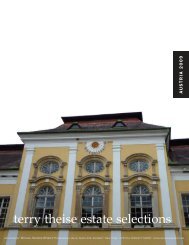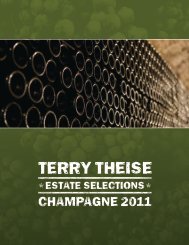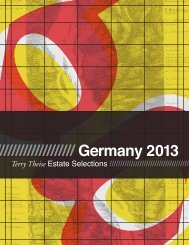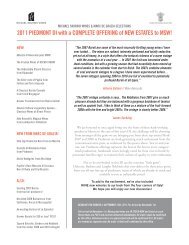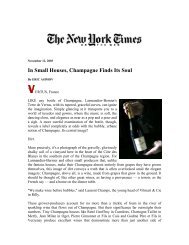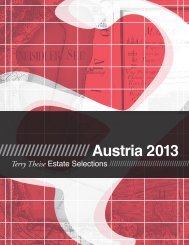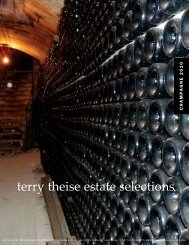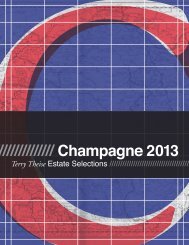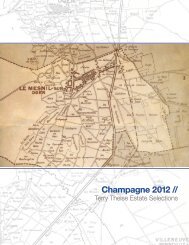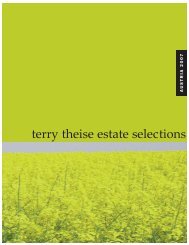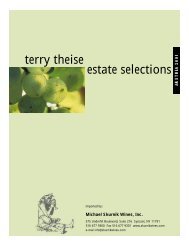German Catalog 2006 USE THIS ONE.qxp - Michael Skurnik Wines
German Catalog 2006 USE THIS ONE.qxp - Michael Skurnik Wines
German Catalog 2006 USE THIS ONE.qxp - Michael Skurnik Wines
You also want an ePaper? Increase the reach of your titles
YUMPU automatically turns print PDFs into web optimized ePapers that Google loves.
A few years ago the <strong>German</strong>s had their French-paradox<br />
moment and everyone was planting Dornfelder.<br />
For awhile the world was crazy; prices were higher for<br />
Dornfelder vines than for Riesling; Dornfelder was more<br />
expensive than Riesling in bulk, and now . . . now? Now<br />
the bloom is off the rose, Dornfelder was not the secondcoming,<br />
there’s dreadful overproduction, you can buy<br />
the wines for under 2 Euro in every supermarket, and all<br />
those poor dupes of fashion are bleeding by the side of<br />
the road saying “What hit me?” And I hardly feel the tiniest<br />
bit of schadenfreude!<br />
But Dornfelder notwithstanding, the Pfalz takes<br />
itself seriously as a red-wine region—rather more seriously<br />
than is warranted by the wines, good though many<br />
of them are. I was heartened when Müller-Catoir told me<br />
they’d hacked out their Pinot Noir and would make only<br />
white wines from now on. The Pinot Noir was good, but<br />
it is even better when someone claims an identity instead<br />
of trying to be all things to all people. Let’s not forget to<br />
resist this ominous urge to homogenize. If we allow it to<br />
grow malignantly the next thing you know we’ll insist on<br />
ripe raspberries all year round.<br />
Oh shit; we already do.<br />
The reducto ad absurdum of all this is the truly<br />
ghastly set of rules applying to the “Erstes Gewächs”<br />
(Grand Cru) program. Everything is perfectly enlightened<br />
— low yields, old vines, hand-harvesting, minimum<br />
necessary ripeness — until the ideologues began<br />
vomiting their ghastly ideas and insisted the wines must<br />
either be DRY (up to 12 grams per liter of residual sugar)<br />
or “NOBLY” SWEET (above 50 grams per liter). It is distressing<br />
to be asked to accept these (often) brutally hot<br />
and bitter wines as arguments for Grand Cru status. It is<br />
distressing to see an entire community of wines straitjacketed<br />
to squeeze into a marketing person’s convenience.<br />
If anyone knows a stealthy little munchkin who<br />
needs a job I’d like to hire him to break into all these<br />
deluded wineries and drop Süssreserve into the tanks.<br />
The Pfälzers are terribly proud of their dry Rieslings<br />
and will draw your attention to any competitive blind<br />
tasting when the wines held their own (or even defeated)<br />
competition from Austria or Alsace. There’s also internal<br />
competition to see who can outdo his colleagues in the<br />
Grosses Gewächs category, and this has brought about a<br />
general improvement in quality. Clearly they had<br />
nowhere to go but up, and any improvement is both welcome<br />
and conspicuous. Certain of the VDP-poobahs in<br />
the Nahe have been heard wondering whether the insistence<br />
on only-dry Grosses Gewächs might have been illadvised;<br />
I heard no such thoughts uttered in the Pfalz. I<br />
hardly heard thoughts at all.<br />
Let’s suppose for argument’s sake they start really<br />
getting it right; they learn whatever magic trick is necessary<br />
to create consistently and sustainably viable dry<br />
Rieslings. Then what? Then there’s one additional region<br />
from which fine dry Rieslings come. What has been sacrificed,<br />
however, is just the thing which makes <strong>German</strong><br />
Rieslings unique. Other places make good dry Riesling,<br />
lots of them. But NO other place anywhere on earth<br />
makes these miraculously beautiful Rieslings with sweetness.<br />
Thus even if — and it’s a big if — Pfalz dry Riesling<br />
was abruptly consistently excellent, I don’t think I’d take<br />
the trade-off. Something one-of-a-kind in return for an<br />
also-ran? No thanks!<br />
<strong>THIS</strong> IS NOT A SCREED AGAINST DRY WINES. I<br />
LIKE DRY WINES! This is a screed against sheep-think<br />
and dogmatic uniformity. I want there to be excellent dry<br />
Riesling from the Pfalz, and I want it alongside Rieslings<br />
with sweetness (and I don’t mean “noble-sweet”<br />
Ausleses) and I want growers and their customers to be<br />
flexible and ecumenical and honest in their tastes.<br />
What is he talking about, you wonder: after all,<br />
there’s plenty of “my” kind of Riesling in my Pfalz<br />
offering. Yes, because my existence as a client creates<br />
these wines, which would otherwise be bottled Trocken<br />
and sold in <strong>German</strong>y. And because I’ve whittled it<br />
down to producers willing to continue making such<br />
The wines have a great affinity for<br />
food—certainly the most versatile of all<br />
<strong>German</strong> wines—and yet they have an<br />
indefinable elegance.<br />
wines. I look very much forward to visiting them; I love<br />
them personally and their wines thrill me to the toenails.<br />
But I feel stifled in their environment, and it’s a<br />
relief to get away again.<br />
Still, what little “sweet” wine one does fine is<br />
uniquely precious. Pfalz wine shows a unique marriage<br />
of generosity and elegance; no other wine is at once so<br />
expansive and so classy. The idea of “class” usually suggests<br />
a certain reserve: NOT HERE! The typical Pfalz<br />
wine has big, ripe fruit, lots of literal spice (cinnamon,<br />
ginger, nutmeg), a kind of lush savor, a keen tang of<br />
pineapple, a splendid tautness of acidity under that<br />
frothing stock pot of fruit. The wines have a great affinity<br />
for food — certainly the most versatile of all <strong>German</strong><br />
wines — and yet they have an indefinable elegance.<br />
From this point the ways diverge. In what other<br />
region could you superimpose the laser-etching of a<br />
Darting with the big burly power of a Koehler-<br />
Ruprecht, with the fiery-yet-satiny persistence of an<br />
Eugen-Müller with the tingly mineral gleam of a<br />
Messmer with the leesy chewiness and compactness of<br />
a Minges with the little-bit-of-all-of-those-high-flyingyou’ll-break-your-crazy-neck-daredevil-glee<br />
of a<br />
Catoir? NFW, that’s where!<br />
153


